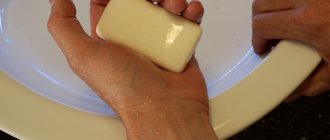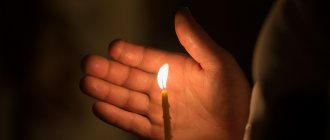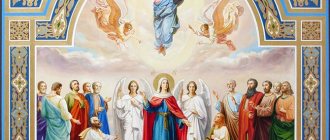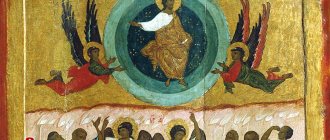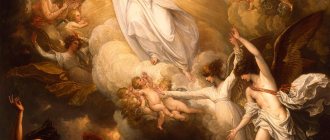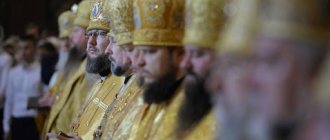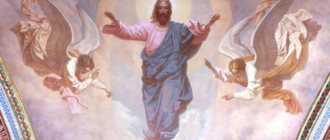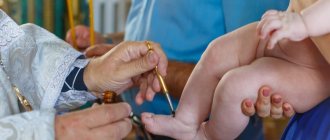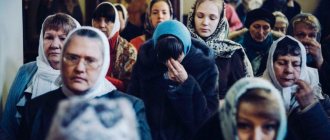Ascension of the Lord - a mobile twelve-day holiday, celebrated on the fortieth day after Easter, that is, it always occurs on Thursday of the sixth week after Easter. On this day, we remember how, after the resurrection, Jesus Christ led his disciples to the Mount of Olives and ascended into heaven, and also made a promise about His second coming. This holiday, established in the time of the apostles, is remembered daily by all Orthodox Christians by reading the Creed.
Ascension of the Lord. Holiday event
After his Resurrection, the Lord appeared to his disciples many times. All the evangelists talk about this. The events after Easter and the Ascension of the Lord God and our Savior Jesus Christ are told in the final chapters of the two Gospels: Mark (Mark 16:19-20) and Luke (Luke 24:50-53). This is also stated in the book of the Acts of the Apostles, compiled by the Evangelist Luke:
I wrote the first book to you, Theophilus, about everything that Jesus did and taught from the beginning until the day on which He ascended, giving commands by the Holy Spirit to the Apostles whom He chose, to whom He revealed Himself alive, after His suffering, with with many true proofs, appearing to them for forty days and speaking about the Kingdom of God. And, having gathered them, He commanded them: do not leave Jerusalem, but wait for what was promised from the Father, which you heard from Me, for John baptized with water, and a few days after this you will be baptized with the Holy Spirit. Therefore, they came together and asked Him, saying: Are you at this time, O Lord, restoring the kingdom to Israel? He said to them: It is not your business to know the times or seasons that the Father has appointed in His authority, but you will receive power when the Holy Spirit comes on you; and you will be my witnesses in Jerusalem and in all Judea and Samaria, and even to the ends of the earth. Having said this, He rose up in their sight, and a cloud took Him out of their sight. And when they looked at the sky, during His ascension, suddenly two men in white clothes appeared to them and said: Men of Galilee! Why are you standing and looking at the sky? This Jesus, who ascended from you into heaven, will come in the same way as you saw Him ascending into heaven (Acts 1:1-11).
“ Today from the Mount of Olives he ascended in glory .” This is such an important event that in the Orthodox Creed it is mentioned after the Resurrection of Christ:
And # ascended to nb7sA, and 3 sedscha nc7a. And again, the one who comes with glory, judges the living and the dead, and there is no end to your life.
The Lord Jesus Christ ascended to heaven in front of the eyes of the Most Holy Theotokos and the apostles from the Mount of Olives. It is the largest peak near Jerusalem (currently located in the suburbs). At the end of the 19th century, during excavations here, mosaic floors of Byzantine churches of the 6th–7th centuries were found.
Rules for decorating a temple for Easter
Unlike the rich and luxurious decoration of Catholic churches, floral decorations are allowed in Orthodox churches, but in a less lavish design. However, not all objects in the temple are allowed to be decorated.
There are no strict standards for decoration, but there are some restrictions and requirements for decorating the house of God. Therefore, today the unspoken rules for decoration are as follows:
- Floral decoration should be in moderation, since an overly rich interior will distract from prayers;
- It is not advisable to decorate a large number of icons in a church with flowers, but it is better to decorate especially revered icons, icons for the Feast, icons at the Royal Doors;
- When composing a composition, flowers should not obscure icons and other church attributes;
- It is advisable to use no more than three types of flowers in the composition;
- You should not choose strong-smelling plants for decoration, so as not to make parishioners feel unwell;
- Plants must not be poisonous or dangerous to humans;
- The festive Easter palette should mostly use white, red, yellow and orange shades;
- When decorating icons with symmetrical compositions, you need to use a mirror match both in length and height, and in the color and size of the flowers;
- According to the shape of the work, it should be done round, rectangular or triangular;
- The composition should look harmonious as a whole.
Following these rules, you can begin the floral design of the temple.
But it is worth noting that the Easter holiday allows for a slight deviation from these rules and allows churches and cathedrals to be decorated a little more magnificently than on other major holidays.
This is due to the fact that the holiday is a symbol of rebirth, resurrection; it expresses the brightest human feelings and speaks of eternal life and salvation for all people.
At Easter, the Shroud, the Royal Doors, elements of the iconostasis, shrines with relics, especially revered icons, the entrance to the temple and arches, and some church attributes are most often decorated, the decision on the design of which is made by the rector.
Ascension of the Lord. history of the holiday
Initially, the celebration of Ascension and Pentecost was not separated. Pentecost was considered a special period of the church year, coming after Easter, and not a separate holiday. Most researchers believe that the celebration of the Ascension and Pentecost (Trinity) was divided after the condemnation of the Macedonian at the Second Ecumenical Council (381).
The celebration of the Ascension of the Lord was established in apostolic times. St. Gregory of Nyssa (IV century) writes that on the fortieth day after Easter the celebration of the Ascension takes place St. John Chrysostom (IV century) also spoke about this in his sermons. Pilgrim Etheria , who visited Palestine in the 4th century, reported that on the Feast of the Ascension, the Christians of Jerusalem gather on Mount Olivet - in the place (called Imvomon) from which the Lord ascended to heaven, and there a service is performed with the reading of the Gospel and the Acts of the Apostles, telling about Ascension of the Lord.
It is no coincidence that the Ascension is 40 days away from Easter. This period of time is mentioned many times in the Holy Scriptures: it rained for 40 days and nights during the Flood, Moses led the Jews through the Sinai desert for 40 years, according to the Law of Moses, on the 40th day of birth, parents must bring the baby to the Temple, the Lord fasted for 40 days in the desert after His Baptism. Thus, the forty-day period is significant in Christian history and tradition.
Royal Doors
The central element of the iconostasis is the Royal Doors. It is to them that the gaze of any person entering the temple turns.
The Royal Doors are the doors leading to the altar and symbolize the entrance to the Kingdom of God. That is why it is customary to decorate them with flowers for various holidays.
Decorating a church for Easter involves the use of live plants, but it is also possible to add artificial elements, for example, in the form of decorative leaves and ivy.
Depending on the architectural form, the Royal Doors can be decorated with both small flower bouquets and long arched compositions. The gates can also be decorated on the sides with standing compositions in vases or Easter eggs on a stand.
The decoration can also be made in the form of a long flower garland, which will rise not only above the gate, but also above the icons located nearby.
The entrance to the altar is decorated with compositions of dahlias, carnations, lilies, roses, tagetis and chrysanthemums, complemented by greenery such as gypsophila, fern, ruscus and salal. Other flowers and greenery can also serve as decoration. Decor options are presented in the gallery.
Decoration of the royal gates with flowers in the photo:
Ascension of the Lord. Divine service
On the eve of the Ascension, Easter is celebrated. On Wednesday evening the festive service begins, its structure is similar to other twelve holidays. The texts of the chants describe the Lord’s ascension to heaven and His meeting with the angels, and also explain the symbolic meaning of the holiday event:
Lord, the sacrament that has been hidden from time immemorial and from generation to generation, having fulfilled itself as Good, came with your disciples to the Mount of Olives, having given birth to You, the Creator of all and Maker. Even though during Your Passion you felt more maternal pain than all others, it is fitting for Your flesh to enjoy much joy. Even as we have received communion, even as Thy Lord rises into heaven, we glorify Thy great mercy upon us.
During the evening service, three proverbs are also read - excerpts from Old Testament books containing prophecies about the Ascension of the Lord. The first proverb (Isaiah II: 2-3) contains a prophecy about the mountain of the house of the Lord, to which all nations will flow and say: Come, let us enter the mountain of the Lord, into the house of the God of Jacob, and He will teach us his ways; in the second (Isaiah LXII, 10-12, LXIII, 1-3, 7-9) the greatness and glory of the Savior is predicted; in the third (Zechariah 14, 1, 4, 8, 11) it is predicted that the Lord will stand on the Mount of Olives and on that day the Lord will be King over the earth:
Behold, the day of the Lord is coming, and on that day they will stand before Him on the Mount of Olives, right in Jerusalem, towards the east of the sun.
At Matins two canons are read. They were compiled by Saints John of Damascus (8th century) and Joseph the Songsinger (9th century). According to legend, the kontakion and ikos for the holiday were composed by the Venerable Roman the Sweet Singer (5th century).
Library of the Russian Faith Canon of the Ascension of the Lord →
Read online
The feast of the Ascension of the Lord sometimes coincides with the day of remembrance of the great saint. In this case, the liturgical Charter contains instructions on how to combine both services.
Troparion for the holiday. Church Slavonic text:
Ascended in the glory of our God, the joy of creating our 1m њbetovanіem s™agw d¦a, and 3informed before ћve blessed for the sake of ћkw you2 є3с2 сн 7b b9ii i3deliverer mjru.
Russian text:
You ascended in glory, Christ our God, bringing joy to them through the promise of the Holy Spirit, and assuring (affirming) them through Your blessing that You are the Son of God, the Redeemer of the world.
Kontakion for the holiday. Church Slavonic text:
He already looked at us, and 3 already on earth2 connected 1 with 8 nbs, ascended in the glory of our God, and 3 in no way rayed, but remained not ttypnw, and 3 vopiS any one tz, ѓz є4cm with you, and3 no one2 same on you2.
Russian text:
Having accomplished our salvation, O Christ our God, and having united the earthly with the heavenly, You ascended in glory to heaven, but did not leave the earth, persistently remaining on it and calling out to those who love You: “I am with you, no one is against you.”
Iconostasis
Not only the Royal Doors, but also the Iconostasis as a whole can be decorated with flowers. When designing the latter, they are based on temple architecture.
You can decorate the iconostasis using bouquets in vases, individual flower arrangements, as well as garlands that differ in weaving techniques.
Making complex garlands is not easy for a novice florist, but professionals can create real floral masterpieces. The most important thing for florists is to create a rhythmic structure with alternating elements, with a given direction of leaves and flowers up and away from the center.
The following flower garlands are distinguished by technique:
- The traditional composition is a dense tiled weave of short-cut flowers onto a base using wire;
- Ampelous composition - flowers are placed in test tubes with liquid and taped on lashes of ampelous plants or long branches;
- An elongated, loose composition - performed on oasis sponges intertwined with each other and attached to a mesh or frame;
- Bouquet arrangement - small bouquets are placed in plastic or metal containers of liquid, then they are attached to a frame. The difficulty lies in decorating the container so that it is not visible;
- A composition with a mixture of techniques - flowers are placed in an oasis sponge or test tube, and then woven onto the base with greenery.
The choice of colors for the garland depends on the chosen technique. For example, for the first and third options, various small-flowered plants are suitable - alstroemeria, asters, carnations, hydrangea, limonium and others.
Examples of iconostasis decoration are presented in the photographs:
Ascension of the Lord. Folk traditions
Ascension Day is the last spring holiday in Rus'. “Spring-Red reached Ascension Day, listened for the last time to how “Christ is Risen” was sung - then the end came for her!” - people say. “Spring ascends to heaven from the Ascension - it asks to rest in the blessed paradise!” - can be heard in Volga villages. “It’s not forever for a girl to be married: why is spring so beautiful, and even on the Ascension of Christ she marries the summer!”, “And spring in Rus' would be glad to last forever, but when Ascension Day comes, it will crow like a cuckoo, fill itself with a nightingale, and by summer it will be in your bosom will be cleared up!”, “Spring will bloom - until Ascension!”, “Ascension Day will come, Spring-Red laziness will be thrown off his shoulders, in the summer he will turn around and pretend to be - he will get to work in the field!” - Russian proverbs are chasing one after another. And spring, indeed, from the day of the Ascension of the Lord, gives way to hot summer with his work on the soil watered with the sweat of the Russian plowman.
According to an old legend, on the eve of the Ascension of the Lord, nightingales sing more loudly than at all other times. They also seem to know that this is the last night of the risen Christ’s stay on earth. Therefore, it is impossible to lie in wait and catch the nightingale, a song bird, on this day. Whoever catches it will not have any spores in it for a whole year, until the new Ascension Day.
According to popular legend, the Savior walks on earth for forty days, from Sunday to Ascension: “By Ascension Day, all the spring flowers bloom - Christ the Father is escorted to the heavenly gardens with secret prayer.”
Associated with the holiday of the Ascension of the Lord is an ancient legend about the Kalikas of the people passing by. According to popular belief, from the Holy Resurrection of Christ until the Ascension, it is a grave sin to refuse all possible alms to a beggar, a wretched stranger; it is a sin not to share with the one asking in the name of Christ if there is something to share.
“The heavens rejoice, And the earth rejoices, Together with people, Always and forever, All the angels, archangels, Heavenly powers, Apostles, prophets With the martyrs and saints, With the saints with everyone, Pleasers of the Lord!” —
sing the poor people of God sitting at church porches on the day of the Ascension of the Lord with cups in their hands.
“Ascend to heaven, O God! Who can speak Your mercy? The lips of Your faithful cannot speak about the immortals. Oh miracles in heaven and sea! The earth is full of Your glory, the mountains, the hills are triumphant, they rejoice, they behold the glory of the Lord. The Mount of Olives rejoices as the Lord ascends into the sky...
On the Ascension holiday, villages baked pies with green onions, and the main special dish was bread “ladders”. Such stairs were always made with seven rungs, like steps, according to the number of the seven heavens of the apocalypse. Previously, these pies and ladders were blessed in the church, taken to the bell tower and thrown down to the ground. At the same time, of course, they wondered which of the seven heavens the fortuneteller was destined to go to. When all seven steps remained intact, this indicated to the fortuneteller the direct path to heaven, and vice versa: if the ladder was broken into small pieces, it thereby revealed a terrible sinner who was not fit for any of heaven.
In many places there was a custom of going to Ascension to visit relatives and friends. In the old days, this was called “walking at a crossroads,” and guests brought the hosts as a gift ladders baked from wheat dough with honey and with a sugar pattern. On this day in old Moscow there was a cheerful spring festivities - in the squares, around the churches.
Icons and shrines with relics
Icons and especially revered tombs with relics are objects that receive a lot of attention from temple floristry. Easter is a great event for the Orthodox world, during which it is customary to decorate these church shrines with flowers.
At Easter, the first thing to decorate is the icon for the holiday, which is called the Resurrection of Christ. In addition to this shrine, they are also decorated with icons of the iconostasis, as well as especially significant temple icons, the list of which each church has its own.
How are icons decorated? They are usually decorated in most cases with floral frames in the shape of the letter U or square, less often in the shape of an oval or semi-oval; for the iconostasis, the decoration is done in the form of an arched shape or a garland.
To create floral forms, take flowers with large buds, such as dahlias, roses, daisies, chrysanthemums, and complement them with large and small greens, fruits, small flowers or berries.
The design can also be made from flowers of the same name in the form of two lines, for example from carnations, with the letter ornament XB, denoting the abbreviated words “Christ is Risen.”
In addition to icons, crayfish with the relics of saints are decorated for the Great Holiday. Their drapery depends on the external shape of the tomb and the possibility of mounting flowers.
Flower arrangements can come in completely different shapes. These are straight lines in the form of lines or rectangles, and curved ones in the form of a winding path, and bouquets in vases, and garlands in the form of vines that completely wrap around the base of the ark and the dome above it.
Flowers can also hang in the form of the Gardens of Babylon, descending from the top of the dome downwards and creating an unusual picture. Lisianthus, orchids and some types of hanging plants are best suited for creating a hanging composition.
In addition to icons and shrines with the relics of saints, various church attributes are also decorated, which complements the atmosphere of the Great Holiday.
Ascension of the Lord. Icons
In the eastern part of the Christian world, until the end of the 4th century, the celebration of the Ascension and Pentecost was still celebrated together, on the fiftieth day after Easter. The Western pilgrim Egeria, who visited the Holy Land around 381–384, reports that on the evening of Pentecost all Christians in Jerusalem gather on Mount Olivet, go “to the place from which the Lord ascended into heaven,” and a service is performed with the reading of the Gospel and Acts apostolic, telling about the holiday. Probably as a result of a single celebration in early Christian art, images of the Ascension and Pentecost are found in the same composition, for example, on an ampoule originating from Palestine, which served as a vessel for shrines brought from pilgrimages. In this miniature composition, God the Holy Spirit is depicted as a dove descending from the wide-open right hand of God the Father.
Ascension-Pentecost. Ampoule. VI century Collection of the Cathedral of Monza, Italy. Prorysya
Sources of the 5th and subsequent centuries already clearly identify the Ascension as a separate holiday on the fortieth day after Easter. The first images of the Ascension that have survived to this day date back to the 5th century, in particular, the avorium, which dates back to the beginning of the 5th century, is a carved ivory plank.
Avory. Beginning of the 5th century Bavarian National Museum, Munich, Germany
Two scenes are inscribed in the avorium: at the bottom are the Myrrh-Bearing Women at the Holy Sepulcher, at the top is the Ascension. Jesus Christ climbs the mountainside, holding on to the right hand of God the Father, extended from a segment symbolizing the Kingdom of Heaven. On the carved wooden door of the Roman church of Santa Sabina (c. 430), the Ascension is depicted in a more traditional form, although with some features characteristic of early Christian art. In the center of the upper register is the Savior ascending in glory, depicted not just as a halo (medallion), but as a large laurel wreath.
Due to theophany, the image of the Ascension was placed in the most hierarchically significant area of the temple - on the vault of the dome. There is an assumption that it was the Ascension that was depicted in the dome of the rotunda of the Holy Sepulcher in Jerusalem, erected by Saint Constantine the Great. This composition was on the vault of the dome in the Church of St. Sophia in Thessalonica, the temples of Cappadocia, the Church of St. Apostles in Pech, the Cathedral of the Spaso-Preobrazhensky Mirozhsky Monastery, the Church of St. George in Staraya Ladoga, the Transfiguration Church on Nereditsa and others.
Ascension of the Lord. Painting of the dome of the Church of St. George in Staraya Ladoga. Last quarter of the 12th century.
In the miniature of the Codex of Rabbulah , originating from Syria, the Ascension is depicted against the backdrop of a picturesque mountain landscape. In addition to the winged tetramorphs, at the base of the mandorla (an oval symbolizing the glory and radiance of the Divine) there are some fiery wheels, which the prophet Ezekiel saw. The entire depicted “structure” resembles an ancient chariot ruled by the Lord.
Ascension of the Lord. Miniature of the Gospel of Rabbi. 586 Laurentian Library, Florence
In the art of the Middle Byzantine period, the Savior was depicted seated on a throne, on a rainbow or on a celestial sphere. This version of the image has become established in iconography, since it best conveys the dogma set out in the text of the Creed: “And # ascended to nb7sA, and3 sat on the right hand of nc7a.”
Ascension. 847–855 Basilica of San Clemente, Rome, Italy
In Ancient Rus', the composition of the Ascension is represented in dome paintings of the 9th–12th centuries - in the Transfiguration Cathedral of the Mirozh Monastery in Pskov, the Church of St. George in Staraya Ladoga, and the Church of the Savior on Nereditsa. In the latter, the drum of the dome was surrounded by the text of the inscription, separating the image of Christ and the angels from the belt of the apostles. 2nd and 6th verses of the 46th Psalm: “All nations clasp your hands, shout to God with a voice of joy. God has risen with a shout, the Lord with a trumpet,” they glorified the already ascended Lord, the completion of His redemptive mission on earth.
Ascension. 1390s. Church of the Assumption of the Blessed Virgin Mary on Volotovo Field, Novgorod
Ascension. The central part of the composition, 1199 Church of the Savior on Nereditsa, Novgorod
In Russian iconostases, the Ascension appears as part of the festive series from the middle of the 14th century. Numerous icons have a single composition. Our Lady in the center, two angels pointing to heaven, and twelve disciples praising Christ, depicted in glory supported by angels. The posture and gestures of the Mother of God vary. Most often She is presented frontally, with her arms raised in prayer or bent at her chest. The apostles are depicted in various positions. On the Tver icon of the mid-15th century, the disciples of Christ do not stand in two static and ordered groups. Each of them is engulfed in movement: one, holding his head, looks into the sky, others point upward with various impetuous gestures, while the apostle standing to the right of Peter, on the contrary, looks down, with his hands folded to receive the blessing.
Ascension. Mid-15th century. From the festive rite of the Transfiguration Cathedral in Tver. Moscow, State Tretyakov Gallery
A new significant detail appears in the Pskov iconography of the Ascension in the 16th century. In the center of the image, under the glory of the Lord, a stone is depicted with the imprints of the Savior’s feet. The outline of a stone with footprints can be clearly seen on the 1542 icon from the Novovoznesenskaya Church of Pskov (Novgorod Museum) and the mid-16th century icon from the festive row of the Pskov Church of St. Nicholas of Usokha (Russian Museum). In both images, trumpeting angels are depicted at the top of the icon.
Icon of the Ascension of the Lord. Novgorod. End of the 15th century..
The icon of the early 17th century by the Stroganov master Mikhail from the Annunciation Cathedral in Solvychegodsk (Russian Russian Museum) shows not only the Ascension Stone, but a rare iconographic detail. The composition of the bottom row includes an additional scene “ Blessing of the Apostles ”, according to the Gospel story immediately preceding the Ascension (Luke 24: 51).
Ascension. OK. 1497 From the festive rite of the iconostasis of the Assumption Cathedral of the Kirillo-Belozersky Monastery. Kirillo-Belozersky Historical, Architectural and Art Museum-Reserve, Kirillov, Russia
Ascension. Middle - third quarter of the 15th century. From the festive rite of the mid-third quarter of the 15th century. from the collections of M. N. Popov and P. D. Korin. Central Museum of Ancient Russian Culture and Art named after. Andrey Rublev, Moscow
Numerous images of the Ascension convey the main joy of the holiday - the joy of Christ, who raised human nature from death to endless life in heaven, where He sat down at the right hand of God the Father.
Ascension of Christ. Last quarter - end of the 16th century. Collection of V. A. Bondarenko, Moscow
Ascension. Mid-17th century The icon comes from the festive rite of the Church of the Assumption in the village of Seksha, Lyubimsky district, Yaroslavl region. Yaroslavl Art Museum, Yaroslavl
Ascension. Mid-17th century Yaroslavl Art Museum, Yaroslavl
Ascension. Descent of the Holy Spirit. Nevyansk icon. Workshop of the Bogatyrevs. Between 1814 and 1822
Shroud
The Shroud is a special shrine in Orthodoxy. It is a canvas with an image of Jesus Christ lying in the tomb. Important religious rites are performed around this plateau both before and after the Great Resurrection of Christ.
The Shroud is placed on a pedestal after being removed from the altar on Holy Saturday. This elevation is located in the center of the temple, so decorating with flowers not only beautifully emphasizes the religious design, but also allows for worship nearby and parishioners to pray.
White plants are traditionally used to decorate the shroud with flowers for Easter. They are complemented with flowers of pink, red or burgundy. Florists place plants of a different range quite rarely, at such a distance as to only create small accents, but not disturb the main color.
In floristry, when composing compositions, a rectangular floral pattern is used, which is more often created from amaryllis, carnations, gerberas, lilies, roses and chrysanthemums than from calla lilies and tulips. Dilute the floral decor with greens or berries, for example, gypsophila or hypericum. The red berries of the latter symbolize drops of the blood of Christ.
Decorating the Shroud with flowers for Easter also allows for additional decorations next to the Shroud in the form of vases, baskets and flower pedestals. Vases and pedestals are chosen in white and filled with tall flowers such as gladioli, ranunculus, roses and chrysanthemums with spiky greenery.
The decoration of the shroud also depends on the wishes of the clergy. So, some priests ask to create floral arrangements with so many flowers that will symbolize the 33 years lived by Jesus Christ. What types of decorations are created, see in the gallery below.
Decorating the shroud with fresh flowers for Easter, photos and pictures:
Temples in the name of the Ascension of the Lord
The Feast of the Ascension of the Lord has long been revered in Rus'. Temples were consecrated and monasteries were built in his name. So, in 1407, Princess Evdokia Dmitrievna, the wife of Dmitry Donskoy, founded the Ascension Convent , in which she herself took monastic vows under the name of nun Euphrosyne. After her death, she was buried in the main cathedral of the monastery - Ascension. The temple became the tomb of princely wives and daughters. Among them are the wife of Vasily I Sofia Vitovtovna, the wife of Ivan III Sofia Paleolog, the mother of Ivan the Terrible Elena Glinskaya, the first wife of the formidable Tsar Anastasia Romanovna, Irina Godunova - the wife of Tsar Fyodor Ivanovich and the sister of Boris Godunov. Marfa Ivanovna, the mother of the first sovereign of the Romanov dynasty, Mikhail Fedorovich, and the mother of Peter I, Natalya Kirillovna, were also buried there. After 1917, the monastery was closed and destroyed in 1929. In its place now stands the administrative building of the Kremlin. When the Ascension Monastery was destroyed, the burial places of the princesses and queens were moved to the basements of the Archangel Cathedral.
Ascension Monastery of the Moscow Kremlin. Destroyed 1929
Other Ascension monasteries and churches have survived to this day. In Pskov, two monasteries were dedicated to this holiday: Starovoznesensky , mentioned in chronicles since 1420, and Novovoznesensky , whose main temple was built in 1467.
Starovoznesensky Monastery in Pskov. Church of the Ascension of the Lord (ROC). Modern look
Another famous Church of the Ascension of the Lord was built in 1532 in the village of Kolomenskoye on the Moskva River . This is the first stone tented temple in Rus'. It does not seem very tall, and only from a distance it becomes clear how huge this temple is, built by order of Vasily III in honor of the appearance of the long-awaited son and heir to the throne. It was presumably built by Italian craftsmen.
Church of the Ascension of the Lord in Kolomenskoye, Moscow
In the name of the Ascension of the Lord, the Cathedral of the Ascension Orshin Monastery in the village was consecrated. Orshino, Kalininsky district, Tver region . The Cathedral Church of the Ascension of the Lord was consecrated in 1567 by Saint Barsanuphius of Tver (c. 1495-1576). There were four thrones in it: the main one - the Ascension of the Lord, two side ones - the Venerable Onuphrius the Great and the Holy Great Martyr Catherine, the throne of the Nativity of John the Baptist "on the floors".
Ascension Cathedral of the Orshina Monastery in the Tver region
, the Church of the Snetogorsk Nativity of the Blessed Virgin Mary monastery in Pskov was consecrated . The church was built in 1527-1528 and belonged to the type of bell-tower temples. The central tower rose on a wide base. The top of the building ended with a tent. In the inventory of 1802, the bell tower is listed as a two-story building with cellars; the Church of the Ascension of the Lord is located on the ground floor. There were 13 bells on the belfry. In 1907, during a fire, all the wooden parts of the church-bell tower burned down. The building was restored according to the design of architect Nazimov. In 1932-1934, the bell tower was dismantled for building material. The material used to build the church was a limestone slab with lime mortar. The basement and part of the walls of the first tier of the church have been preserved. In the 1950s, conservation of the ruined remains of the church-bell tower was carried out.
Ruins of the Church of the Ascension in Pskov
In the name of the Ascension of the Lord, the gate church of the Spaso-Prilutsky Monastery in Vologda . The Spassky Cathedral of the Spaso-Prilutsky Monastery, built in 1537-42, is the first stone church not only in the monastery itself, but in all of Vologda. Until 1537, a wooden cathedral of the same name stood on the site of the current Spassky Cathedral. A wooden church in the name of the All-Merciful Savior and the Origin of the Honest Trees of the Life-Giving Cross was erected on the site chosen by him for the establishment of the monastery by the Venerable Demetrius of Prilutsky. When the wooden cathedral burned down, a stone one was built. In the northern wall of the stone fence of the Spaso-Prilutsky Monastery there is the former main entrance to the monastery - the so-called Holy Gate with a small gate church of the Ascension of the Lord, built shortly after the cathedral Spassky Church. Initially, the church was consecrated in the name of the Holy Great Martyr Theodore Stratilates and was called that until the 19th century. In the 18th and early 19th centuries, as a result of fires in the monastery, the church was badly damaged and remained in this condition until 1815, when it was reconsecrated in the name of the Ascension of the Lord. The Ascension Gate Church is very simple in composition and at the same time original. Its cubic volume, modeled on the most ancient gate structures of Rus', is devoid of altar apses, this typical element of a church building. The temple is completed by one light dome, originally installed on two stepped pyramidal tiers of kokoshniks. The kokoshniks did not correspond to the design of the vaults and were decorations that enhanced the slender silhouette of the entire building. During the Soviet years, the monastery was plundered. In the 1930s, the monastery housed a transit prison for dispossessed people who were transported to the northern Gulag camps; in the 1950s-70s, the territory of the former monastery was occupied by military warehouses. Only in 1975-79, the central group of monuments with the adjacent territory, after restoration began in 1954, became a branch of the Vologda State Museum-Reserve. Thanks to the scientific restoration carried out in 1954-1975, monuments of the 16th-17th centuries. the supposed original appearance was returned. Currently, the Spaso-Prilutsky Monastery is active.
Ascension Church of the Spaso-Prilutsky Monastery in Vologda
In the name of the Ascension of the Lord, a church on Nikitskaya Street in Moscow . Initially the temple was wooden, and in 1634 it was rebuilt in stone. The building is distinguished by its volumetric-spatial design and the nature of its decorative design. The facades of the high two-height quadrangle, elongated along the north-south axis, are processed with promising vertical panels, which have analogues in 16th-century architecture. During the XVII-XIX centuries. V. The appearance of the building has undergone significant changes. The church was closed 1937-1992. Currently in effect.
Church of the Ascension of the Lord on Nikitskaya Street in Moscow
In the name of the Ascension of the Lord, the church of the former Novovoznesensky nunnery in Pskov . The temple was built in 1467 and previously belonged to the Novovoznesensky convent, which stood in this place since the 14th century and was abolished in 1764. In 1786 he was converted into a parish, and then assigned to the Anastasyevskaya Church. The church is made of slabs. Its length with the belfry is 10 fathoms 2 arshins, width is 7 fathoms, height to the upper cornice is 4 fathoms. The eastern part has two semicircular apses: large and small. The cornice of the drum is decorated with belts of triangular depressions, its slit-like windows are filled in and decorated with edges on top. On the west side of the church there is a belfry on which two ancient bells hang. Four tombstones are visible on the church porch: two of them date back to 1644, the rest are heavily covered over. Above the entrance door there is a pediment niche made from the inside. There are no pillars in the temple, and the closed vaults rest directly on the walls. Soon after the 1917 revolution, the Church of the Ascension of the Lord was closed. Until now, it houses the depository of the Pskov Museum-Reserve.
Church of the Ascension in Pskov
In the name of the Ascension of the Lord, the church of the former Starovoznesensky Monastery in Pskov . The Old Ascension Monastery has been known since the 14th century. The center of the monastery is the Old Ascension Church, built between 1550 and 1600. The temple is single-domed, three-apse with a porch and a three-span belfry, a porch on pillars; the interior has four pillars with raised girth arches. The church stands on a vaulted basement. The decor is traditional: blades, a runner and a curb at the end of the apses and drum. The bell tower was built no later than the beginning of the 18th century. During the Great Patriotic War, the church lost the drum with the head over the quadrangle of the 15th century, and the chapel was destroyed in 1880. From 1956 to 1960. Research and restoration work was carried out at the Old Ascension Church. Currently a functioning parish church.
Old Voznesenskaya Church in Pskov
In the name of the Ascension of the Lord, a church was consecrated in Rostov the Great, Yaroslavl region . The Church of the Ascension, otherwise called Isidore the Blessed on the Ramparts, is one of the oldest stone churches in Rostov. The church was built in 1566 on the burial site of Blessed Isidore. This is a pillarless temple covered with a cross vault. The outer walls are divided into three parts by blades and have a three-bladed finish. In the 18th and 19th centuries. The church was rebuilt several times. In 1930 it was closed and transferred to the jurisdiction of the Rostov Museum. In 2002, services were resumed in the temple.
Church of the Ascension of the Lord in Rostov the Great
In the name of the Ascension of the Lord, the cathedral of the Zhichsky Ascension Monastery in the village was consecrated. Žiča Serbia . The temple was built between 1206 and 1217. Also in honor of the Ascension of the Lord, the Church of the Ascension Neametsky Monastery in Romania . The church dates from 1497.
Church attributes
Each church contains many church attributes, which either serve as a necessary item of church interior, or are used during services. But some temple utensils are decorated during festivals.
Decorating a temple for Easter involves adding floral arrangements for the following attributes:
- A lectern is a special wooden table-stand on which an icon, a cross or a church book is placed. It is customary to decorate the lectern with nearby compositions, for example, triangular ones. Easter eggs made of flowers can also be added to the lectern on both sides;
- Remote candles are decorated at the bottom with small flower bouquets, which include several large flowers, for example, gerberas or roses, complemented by small inflorescences or various greens;
- The cross, one of the important objects in Orthodoxy, is placed on a pedestal and surrounded with flowers, creating a cross or oval shape using an oasis sponge. To highlight the cross, it is better to choose large flowers and frame them with large green leaves. For example, a good combination is carnations with asparagus leaves or roses with fern leaves;
- Candlesticks are decorated with climbing plants with the addition of large flower buds, framed with ribbons and strings of beads. The decoration can also consist of small bouquets with small inflorescences, also complemented by decor in the form of ribbons, braid, beads and small Easter eggs;
- The chandelier is the main chandelier in the temple, which is often decorated during Easter. The chandelier has a round multi-tiered shape, but mainly the lower tier is decorated with flowers. To do this, create a floral wreath, for example from chrysanthemums and greenery, and hang it from the bottom of the chandelier. Hanging arrangements in the form of small bouquets or flower balls can also decorate a chandelier.
Also, the church hall can be decorated with various hanging elements in the form of Easter eggs, flower garlands on the walls and other compositions.
There are various master classes on decorating temple utensils in a church, some of them are simpler, others are more complex, but we will look at the lesson: how to make a large Easter egg - a symbol of the Great Holiday.
Old Believer churches in the name of the Ascension of the Lord
The Old Believers continued the ancient Russian tradition of building Ascension churches. Today the patronal holiday is celebrated by the community of the Russian Orthodox Old Believer Church in the village. Baranchinsky, Sverdlovsk region and Belokrinitsky parishes in the cities of Tulcha, Tyrgu Frumos and the village of Novenkoe. In the USA - Pokrovo-Voznesensky Belokrinitsky parish in the city of Gervase.
Church of the Ascension of the Lord ROC village. Baranchinsky, Sverdlovsk region
In honor of the Ascension, the temple of the Russian Ancient Orthodox Church in the city of Zlynka, Bryansk region, was consecrated.
Church of the Ascension of the Lord (RDC). Zlynka
The temple holiday is today in the communities of the Ancient Orthodox Pomeranian Church in Lithuania - Ladziya (Nekrun) and Turmantas.
Church of the Ascension of the Lord (Cathedral of the Ascension of the Lord). Turmantas, Lithuania
Also, in honor of the Ascension of the Lord, a church of the same faith was consecrated in the village of Mistsevo, Orekhovo-Zuevsky district, Moscow region.
Is it possible to get a haircut before the Ascension?
You can get your hair cut before the Ascension, and after the Ascension, and on any day of the church year when you need it. Another thing is that you should not sacrifice a visit to the temple, preferring an appointment at the hairdresser to the festive service.
The church day begins in the evening, and on Wednesday evening the festive All-Night Vigil is served on Ascension, and on Thursday morning the Liturgy is celebrated. In addition, on the eve of the Ascension, the Easter period ends and on Tuesday evening and Wednesday morning Easter chants are heard for the last time this year.
Hair salons are open every day, and you can find time at a time when most believers are trying to be in church.
What should you not do from Easter to Ascension?
From Easter to Ascension, after a long period of abstinence, you cannot let yourself go, relax, or lose everything that was acquired during Lent. You cannot decide with relief: “Now I will rest until the next fast,” and allow yourself to live, forgetting about God. During the period from Easter to the Ascension, one cannot completely shift the focus of one’s attention from the spiritual to the everyday, as if there had been neither the Resurrection nor the events that followed it.
For forty days from Easter to Ascension, the Church calls us to rejoice, and no prostrations are made until Trinity. The feast of the Ascension itself combines bright sadness, joy, and expectation.
The Ascension ended the period of the Risen Christ’s stay on earth, and with the Ascension the Lord opened the way to heaven for all people, and ten days later the descent of the Holy Spirit, the Comforter, took place. The Easter period is ending, but the joy of the Resurrection of Christ remains with us, and in just ten days the Church will celebrate Trinity, the birthday of the Church. During this period - from Easter to Ascension and from Ascension to Trinity - the connection between the modern church calendar and the events that took place two thousand years ago is very clear. And living this period together with the Church, visiting church, participating in divine services, a Christian does not lose, but strengthens the connecting thread that stretches through the centuries from Christ’s disciples to each of us.
https://foma.ru/voznesenie-chto-mozhno-i-chto-nelzya.html
Is it possible to read the Psalter from Easter to Ascension?
The Psalter from Easter to Ascension can be read starting from Antipascha, that is, the Sunday following Easter.
The Psalter is an Old Testament book consisting of 150 songs (psalms) addressed to God. Throughout the year, it is heard daily in churches at all services, and many believers also read one or more kathismas (parts) at home. Only for ten days - from Maundy Thursday to St. Thomas week (Antipascha) - the Psalter is not read. From St. Thomas Sunday, the reading of the Psalter resumes.
How to give away jewelry?
Not all works are suitable for alms. And you won’t be able to simply hang a thing on an image - you first need to comply with some formalities.
First of all, decide on your donation. Be sure to make sure that there are no third-party patterns on the product that are not consistent with Christian symbols - otherwise the whole meaning of why decorations are hung on icons will be lost. There is no need to give items with pentagrams, skulls, runic inscriptions or hieroglyphs. Preference is given to gold and silver medallions, crosses and incense, chains without pendants, bracelets, simple and smooth rings, rings with one or more gems.
When you have selected a suitable accessory, give it to your confessor or other clergy member. During the next prayer service, your gift will be consecrated, and only after that will it be attached to the icon with honor.
Theological interpretation of tradition
People have always appealed to higher powers, asking for help and support. And when their aspirations came true, believers showed their gratitude by giving valuable things to the gods. Similar rituals are often found in the Old Testament. They are first described in the story about the descendants of Adam: “Cain brought a gift to the Lord from the fruits of the ground, and Abel also brought from the firstborn of his flock and from their fat” (Gen. 4: 3-4). And in the book of Exodus, the Creator commands Moses: “Make Me an altar of earth and offer on it your burnt offerings and your peace offerings, your sheep and your oxen” (Ex. 20:24). Through such rituals, people demonstrated submission to the Lord, atone for sins and cleansed themselves of filth.
Tashlin Icon of the Mother of God “Deliverer from Troubles”
In Christianity, the meaning of sacrifice has completely changed, because Jesus himself became the lamb going to the slaughter. Dying on the cross, the Son of the Lord gave humanity a chance to be delivered from hellish torment. And a reminder of the Savior’s mercy is the Eucharist (in Greek “εὐχᾰριστία” means “gratitude”) - an amazing sacrament when bread and wine acquire the essence of spiritual flesh and blood. By taking the sacrament, people unite with the Creator, receiving a piece of His grace.
But in order to be rewarded with closeness to the Creator, the Eucharist is not enough. It is necessary to follow Jesus' commandment, “Love one another, as I have loved you.” Greater love has no one than this, that someone lay down his life for his friends” (John 15: 12-13). According to the teachings of the Son of God, it is unselfish, selfless affection for others that is the main source of sacrifice. But the size of the alms is not so important - this is evidenced by the parable of the poor widow and the two mites: “...she put in more than everyone else who put into the treasury, for everyone put in out of their abundance, but out of her poverty she put in everything she had, all her food "(Mark 12:43-44).
Svyatogorsk Icon of the Mother of God
It follows that decorating icons is a different type of sacrifice. People turn to the Lord with problems - from physical weakness to spiritual quests - and He shows the right path, forgives unkind transgressions, and protects from depressing experiences. And in gratitude for this assistance and patronage, a person gives his favorite accessories to the church.
Such offerings are called votive objects (from the Latin word “votum” - “vow”). As a rule, they are done after healing a serious illness or resolving a difficult situation. In Orthodoxy, gifts are attached on chains to the icon at which the believer prayed, and they are visible evidence of the miracle that occurred.
